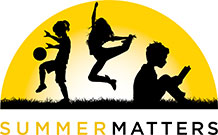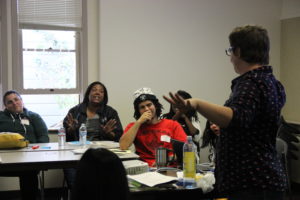End of Summer Program Reflection
August 11, 2017
Meeting Objectives to:
- Celebrate the accomplishments of program
- Generate solutions to common program challenges
- Share programs best practices
- Apply a strategic management model to turn data into action plans
- Determine root causes of performance gaps and develop strategic responses
Meeting Outcomes:
- Participants have identified actions and ideas to improve their program in 2017
AGENDA:
- Reflection (45-60 min)
- Provide staff with opportunity to reflect on their growth, learning and successes working on campus this semester.
- Reflection towards continual personal and professional development
- Celebrate programmatic impact
Activity Options:
- For the visual learners:
- Draw a picture that demonstrates a moment of real pride or success working with a young person or their team.
- Draw a map of your journey here today as a road map, what would it look like? Would it be a straight path from beginning the summer program to sustainability and surpassing all youth goals? Would there be forks in the road because decisions were made that led your program down a certain path? A bumpy path or smooth freeway? What traffic signs would be along the way? What would the speed limit on your road be? What would the scenery along the road be?
- Things to consider on your road map:
- Did your program change goals? Why? What happened as a result?
- Did your program collaborate with a new group?
- Did your program get new staff in leadership / decision making roles? What happened as a result?
- Did something happen that encouraged you to try something new?
- Did you set a goal and achieve it quickly?
- Did you set a goal and encounter obstacles when you tried to achieve it?
- Things to consider on your road map:
- For kinesthetic learners, write names of staff member on individual pieces of paper and post around the room.
- Read off a 2- of prompts – having staff respond by standing in front of team member name that best illustrates the questions.
- Have 2-3 individual staff share with group why those chose particular person. Ensure each person shares at random by pulling name out of hat or going in order of signs.
- Example prompts include:
- If you were a student, whose team would (or wouldn’t) you want to be on?
- Which staff member was most likely to make a post program meeting fun?
- Which staff member do you think grew the most?
- Which staff member would be the most likely to earn [specific star]?
- For auditory learners, tell a story of a moment where you saw a child succeed
- For those looking for humor, ask each staff member to write the name of a child in your program that you were most like in middle school and have your staff guess your doppelganger!
- Program Assessment (30-45 min)
- Create Your Garden
- Using the metaphor of program as a garden, draw a garden on banner paper or flipchart paper taped together – representing campus over the course of the year or semester.
- Divide the garden into various fruit and vegetable plots labeled with program elements/activities (see below)
- In advance, get a stencil, dye cutter, or post-it note shapes to cut out flowers (demonstrating success) and weeds or rocks (demonstrating challenges). Make sure each staff has 5 flowers and 5 rocks to write challenges/success and place in the correct garden plot.
- You can then group “like” items with “like” items so that you are recognizing themes.
- Once themes are identified, title the themes and write them up for all to see.
- Data Analysis (60-90min)
- Review the strategic planning / visioning phase of the CQI
- Approach program reflection from new perspective with data. Use variety of data sets to describe the current state of the district as to what is going well and what the challenges are
- Some data sources to consider:
- Attendance
- Students, staff, families, teachers, surveys
- Grade and/or school test scores
- Program quality observations / assessments
- Student demographics
- School/ district LCAP and other strategic plans
- Stakeholder anecdotes
- Ask- What does tell you? How is this that data point significant, why does it matter?
- Conduct a SWOT analysis – Where are strengths, Weaknesses, Opportunities, Threats)
- Repeat bucketing activity from garden activity. Find themes and add new themes to existing themes from garden activity.
- (OPTIONAL) – Best Practice Fair (30-60min)
- Example Activity 1: (for 30 participants)
- People get A, B, C, D, E, F and a number 1-5 on their name badges
- Each table has color on table tent
- Participants sit in color mixed groups
- 30 people, 5 ppl x 6 tables
- Each person presents for 5 min
- After each presentation Q & A for 3 minutes
- 3 minutes for individual time to think
- Repeat at new table.
- Move people: #1 move to next Alpha A to B, B to C
- #2 move down two Alpha A-C, B-D
- # 3 move down three Alpha A to D, B to E
- # 4 …
- #5…
- Example Activity 2:
- Identify a star strength of each site or each participant in the debrief and ask that they prepare a short presentation of the strength
- Ask each participant to prepare the following:
- What key information or overview can you share about this resource, practice or tool?
- Why did you select this resource, practice or tool to share?
- How have you used this resource, practice, or tool?
- Do you have any suggestions for others who would be interested in using or adopting this resource, practice or tool (e.g. modifications, cost, timeframe, etc.)?
- Where would you recommend to go for more information?
- Quality Improvement Plan (30-90min)
- Ask your staff to go back to themes from reflection and vote on the most significant successes and challenges/opportunities for improvement. These themes should lead you into the next portion of this activity.
- Either break your staff up into small groups, each group will discuss one of the top vote-getting challenges or post top vote-getting challenges on flip chart paper and have staff circle room graffiti style.
- Ask the group to brainstorm solutions to the challenges—how can next semester’s staff and program overcome these obstacles? — and present them to the full staff team.
- If time permits, as group prioritize 3- 5 for each of the following:
- Program accomplishments (what you’d like to see continue the following semester) and
- Challenges (the rocks that you faced, and the ways you’d like to improve, and suggestions for improvement).
NOTE: Please ensure that all staff members have the opportunity to respond, and add to the brainstorm, to ensure maximum buy in.
- Use this list to share with other program planning partners, e.g. district coordinator, board member, superintendent, etc.
- After program partner meeting create a Quality Improvement Plan with three improvement goals.
- Closing & Appreciations (15-30 min)
- Human Sculpture-In a large open space, divide your group into two halves. Each half creates a sculpture around a key word or phrase that describes something they look forward to working on in following program year. Then each group displays its ‘art’ for the other group. The watching group can interpret the sculpture, without disruption, for two minutes. When they’re finished, the sculpture group can explain its work.
- Present staff awards, certificates of appreciation that reflect your program theme
- Allow staff to share appreciations by asking that each person write on star* one way each other staff person contributed their “star power” to the program.
- Share next steps, how information from today’s meeting will be used moving forward and when they’ll see what’s next.
*use object that most reflects program theme




